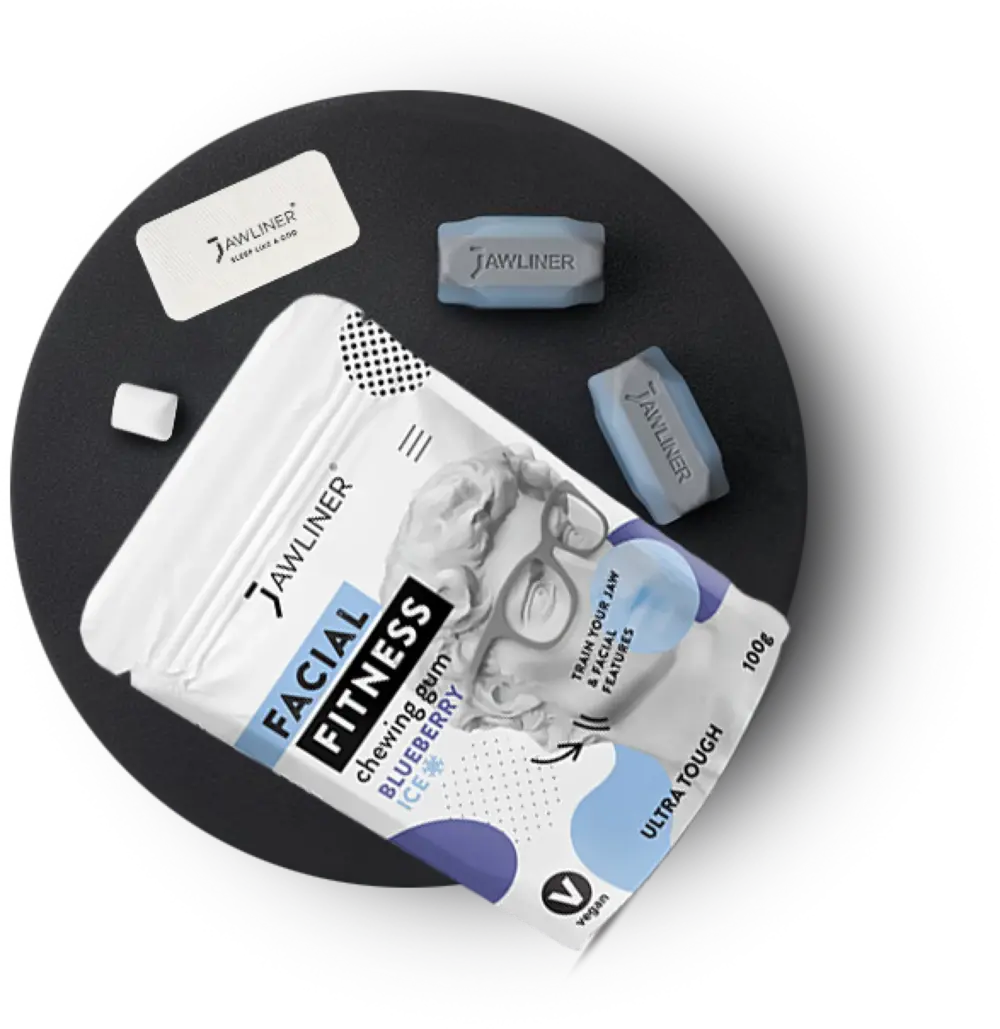A weak chin and jawline can quickly make the face appear soft or unbalanced. Many men therefore want a striking jawline—clearly contoured, defined, and harmonious. The obvious solution: jawline injections with hyaluronic acid or fillers.
But is it really worth it? The treatment promises quick results, but it also has some disadvantages. In this article, you will learn what actually happens when you get jawline injections, how long the effect lasts, and when exercise becomes a real alternative.
What does “jawline injections” actually mean?
Jawline injections involve targeting the jaw area with hyaluronic acid fillers to visually emphasize the chin line and give the face a clearer structure. The aim is to achieve a more precise contour that makes the profile appear more striking and harmonious.
The procedure is one of the most popular minimally invasive treatments in the field of aesthetics. Depending on the shape of the face, it can be used to create a soft transition between the chin and neck or to emphasize a weak jawline. Specialists often refer to this as jawline contouring or jawline correction.
It is important to understand that jawline injections do not change the muscles, but rather shape the volume under the skin. The result is therefore purely visual—not due to muscle definition, as is the case with targeted jaw training.
How much does jawline injection cost and how long does it last?
The results of jawline injection usually last between 9 and 18 months. How long the effect remains visible depends on your individual metabolism, the quality of the hyaluronic acid filler, and the extent of the treatment. Over time, in the best case scenario, the material is broken down by the body and the jawline gradually loses its contour again. However, the filler often does not break down completely, but slips downwards. This can lead to sagging cheeks, which can only be corrected by a skin tightening procedure.
The costs vary depending on the practice and product, but are usually between $300 and $800 per session. In many cases, several treatments are necessary to achieve or maintain the desired result. This results in ongoing costs that are significantly higher than a one-time training effect.
Anyone considering a jawline treatment should realistically plan for the financial outlay and limited durability – and ask themselves whether natural definition through training, such as with the MEWING RING is the better solution in the long term.
Procedure and method of jawline treatment
Jawline treatment is usually performed on an outpatient basis in an aesthetic practice, takes around 30 to 45 minutes, and requires only a few steps:
- After a brief consultation and preparation, the skin is cleansed and treated with an anesthetic cream so that the injections are barely noticeable.
- The specialist then injects the hyaluronic acid filler precisely along the jawline and around the chin to create the desired contour. It is not a question of quantity, but of millimeter-precise placement—even small adjustments can significantly change the facial proportions.
- After the treatment, there may be slight swelling or redness, which usually subsides within a few days.
- The final result is visible after about a week: a clearly defined jawline and a visually more stable facial contour.
It is important that jawline injections are only performed by an experienced specialist to avoid complications in the sensitive jaw area.
Jawline injections – how do they change the chin and jawline?
The aim of jawline injections is to achieve a clearly defined chin and jawline, which makes the face appear more harmonious. Targeted filling with hyaluronic acid fillers gives the jaw area more structure, making the profile appear firmer and more distinctive.
Differences between men and women
Depending on the shape of the face, the definition can be customized individually—often slightly more angular for men, usually softer for women and proportionate to the other facial features. The result: a visible but natural emphasis on the jawline and a visual rejuvenation through improved facial proportions.
Aesthetics only, no training
Nevertheless, the effect remains purely aesthetic. The treatment does not strengthen the muscles, but only shapes the tissue under the skin. Anyone who wants a permanently accentuated jawline must have the procedure refreshed regularly or train the jaw muscles specifically.
The most important muscle here is the masseter muscle, one of the strongest muscles in the face, which visibly gains volume with regular training and shapes the jawline in a natural way.
Jawline injections: Risks and side effects
As with any aesthetic treatment, there are risks associated with jawline injections that you should be aware of in advance:
- Short term (immediately after treatment): Often slight swelling or bruising, which disappears on its own after a few days. In some cases, unprofessional procedures can also lead to inflammation or permanent paralysis of the face.
- Medium term (within a few days/weeks): Imprecise injections or the use of inferior fillers can cause asymmetry, hardening or, in rare cases, vascular constriction.
- Long term: Over time, the face may appear unnatural, especially if repeated injections are given. A so-called sacking effect—i.e., the sagging of the tissue over time—is also possible if the injection is too deep or uneven.
Treatment by an experienced specialist who is familiar with the anatomy of the jaw area can minimize this risk, but it cannot be completely eliminated.
Jawline injections vs. jawline training – which is better?
|
Jawline training |
Jawline injections |
|
The masseter muscle, i.e., the powerful chewing muscle, is specifically activated and grows. → The jawline appears wider, firmer, and more naturally defined. |
The defined contour is created exclusively by the injected hyaluronic acid. → Tissue under the skin is filled and the jawline becomes more visually prominent. |
|
The body shapes itself, completely without injections or foreign substances. |
Minimally invasive procedure with hyaluronic acid gel required. |
|
Health benefits: Strengthens the muscles, improves facial symmetry, and can reduce tension in the jaw area. |
No health benefits |
|
Risks: Jawline training should not be performed in cases of temporomandibular joint inflammation. |
Risks: General health risks associated with invasive procedures: swelling, redness, bruising, infection, allergic reactions, and even blindness or stroke. |
|
Regular jawline training creates a lasting definition → more sustainable |
Jawline treatment with fillers delivers immediately visible results → faster |
|
Jawline training is reversible after discontinuation. |
Injections can cause permanent deformities. |
Jawline surgery – the permanent alternative
In addition to fillers and training, some people opt for jawline surgery if they want a permanent change to their jawline. This involves surgically reshaping the chin and jaw area – for example, through implants, bone shaving, or a so-called thread lift.
More effect, more risk
Although these procedures offer a permanent effect, they are significantly more invasive. Surgery requires anesthesia, carries medical risks, and causes longer healing times. Swelling or feelings of tension often occur and can last for several weeks.
Higher costs
Compared to injections, surgery is significantly more expensive and risky. For many, it is therefore only an option if other methods – such as hyaluronic acid fillers or targeted training – do not produce satisfactory results. Anyone who decides to undergo surgery should always put themselves in the hands of an experienced specialist who specializes in aesthetic jaw treatments.
Jawline injections: experiences & before and after results
Numerous before and after pictures online show impressive effects after jawline injections. Many report a fresher facial expression and increased attractiveness.
However, there are also other experiences. Some patients find the effect too artificial or notice slight asymmetries after some time. Especially with repeated treatments, the tissue can change or the natural shape of the face can lose tension.
(Insert before and after pictures)
This is where the biggest difference to jawline training with the JAWLINER 3.0: While fillers only temporarily change your appearance, training strengthens your muscles permanently and therefore looks more natural. A trained jawline remains stable, even if your weight fluctuates or the hyaluronic acid has long since broken down.
Frequently asked questions about jawline injections
How do jawline injections with hyaluronic acid work?
In a jawline injection, hyaluronic acid is injected specifically along the jawline to build volume and emphasize the contours. The filler evens out unevenness and ensures a clearer chin line. The result is immediately visible and gives the face a more distinctive shape.
How long do jawline injections really last?
The results usually last between 9 and 18 months. How long the effect lasts depends on the individual's metabolism, the filler used, and the injection technique. After that, the hyaluronic acid is broken down by the body and the contour becomes softer again.The most common side effects include slight swelling, redness, or bruising, which disappear after a few days. Less common are asymmetries, lumps, or a so-called sacking effect when the tissue changes. Treatment should therefore always be performed by an experienced specialist. Is jawline injection painful?
Usually not. The skin is prepared in advance with an anesthetic cream, and many hyaluronic acid fillers also contain a mild local anesthetic. This means that the treatment is usually well tolerated.
Can you define the jawline without fillers?
Yes – targeted jawline training can build up the jaw muscles, resulting in natural and lasting definition. The training strengthens the masseter muscle, promotes facial symmetry, and improves the jaw contours in the long term, without any surgery.
Which is better—jawline injections or training?
Both can work—it depends on the desired result. Fillers deliver quick, visible results, but they are temporary and costly. Exercise works gradually, but creates real muscular change with lasting effects. If you are looking for naturalness, safety, and sustainability, you will benefit more from exercise in the long term.






